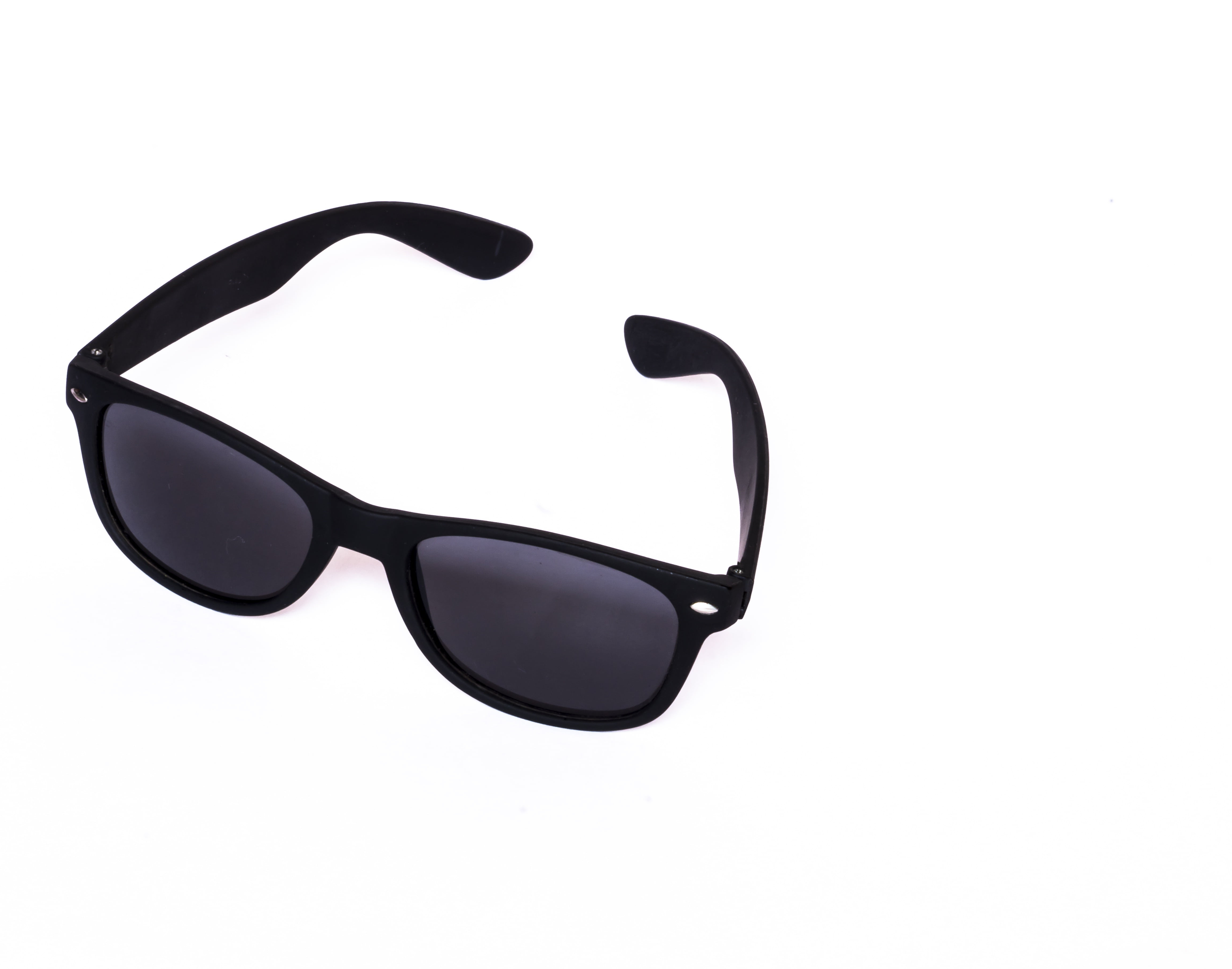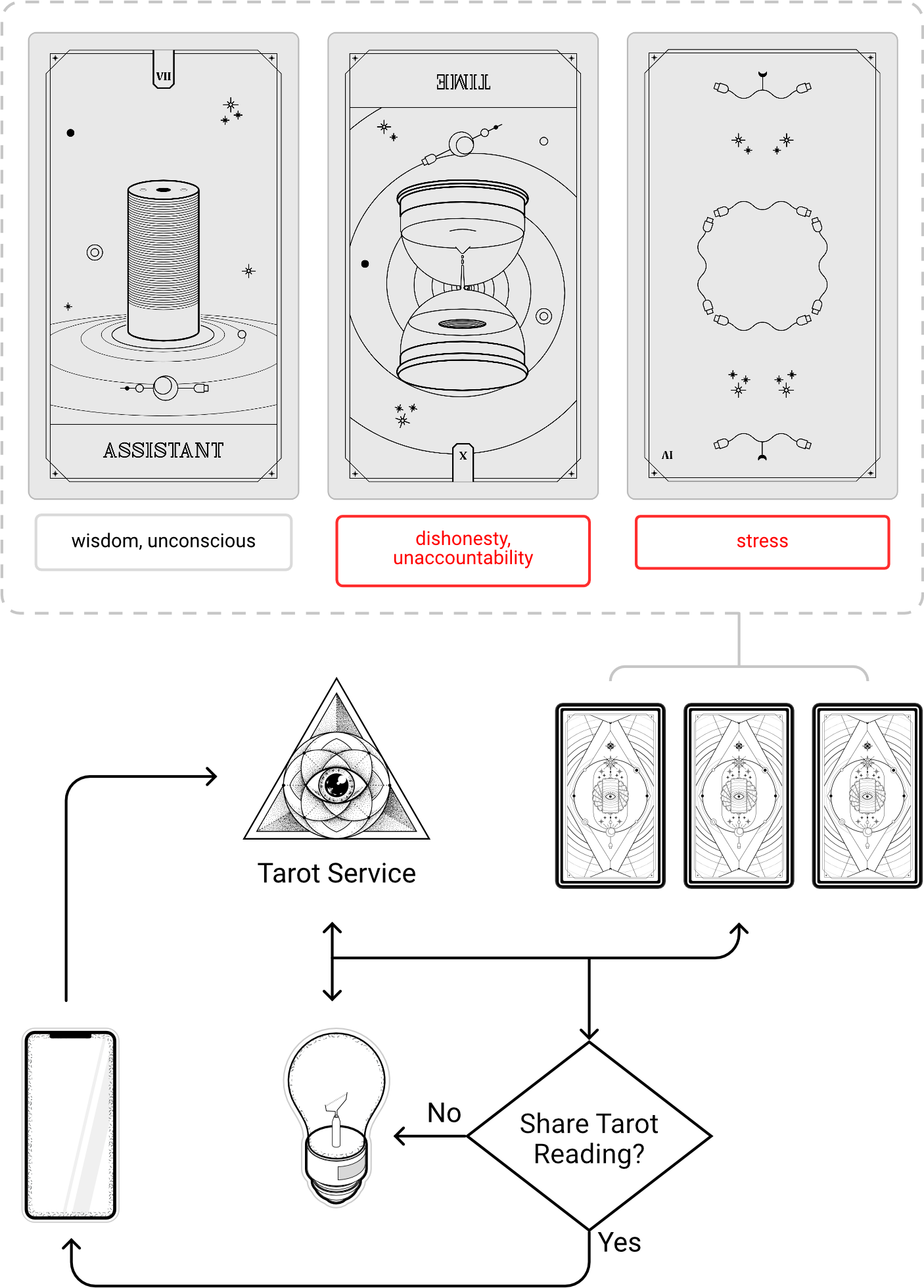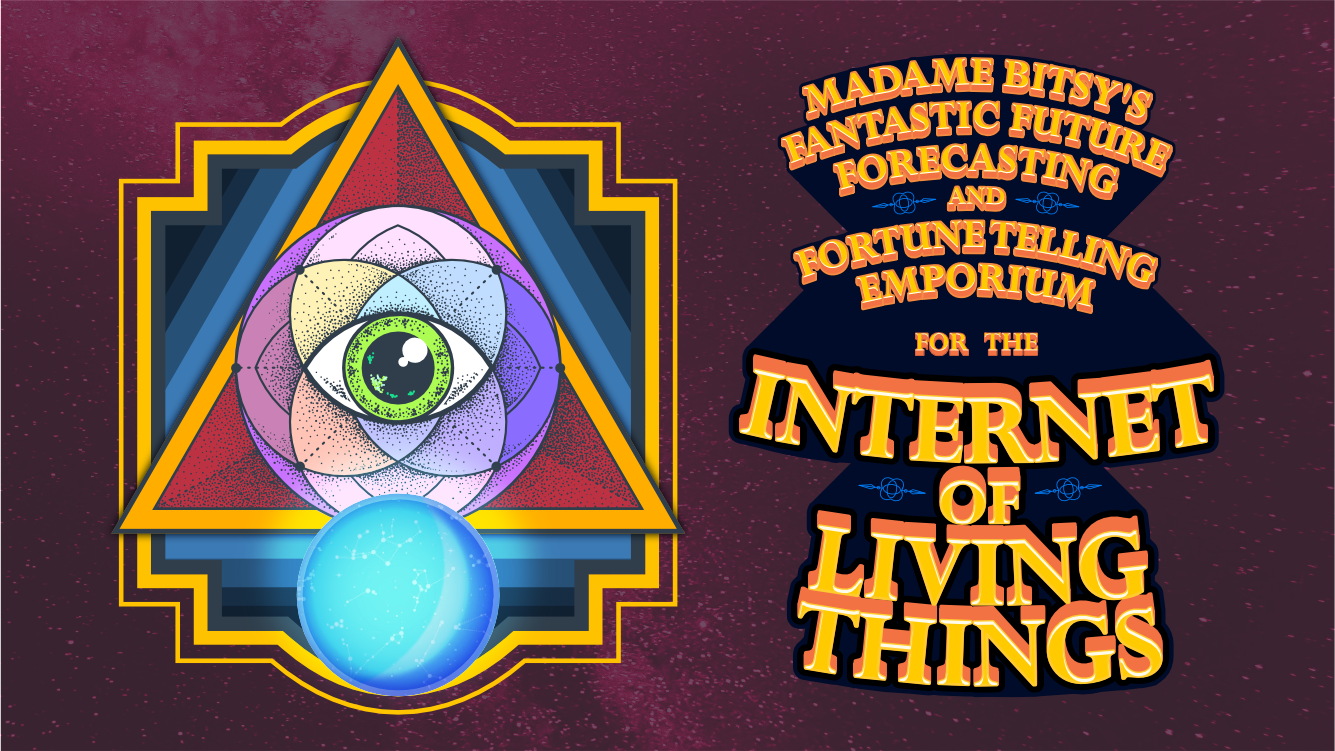Tarot of Things
A supernatural approach at desiging for IoT
“Given that God is infinite, and that the Universe is also infinite...would you like a toasted teacake?”
Talkie Toaster from Red Dwarf (1991)
Premise
What’s it like to be a toaster? Could garden gnomes be scheming behind our backs? Does the refrigerator miss me when I’m not randomly opening its door to see what’s in? What does/could a fork aspire to be? Though these might sound like silly questions to ask, they also are philosophical ponderings into the vicarious lives of non-human objects existing among us. The Tarot of Things attempts to question the agency of objects from a more-than-human philosophical perspective, where ‘smart’ toasters and refrigerators exist out their lives in the peripherals of our own.
Challenges
- How does one see from the eyes of the non-human?
- How to translate non-human agency into a readable language for design execution?
Methodology
- Research through Design
- Speculative Design
- More-than-human Centred Design
- Object Oriented Ontology
Background
In The Uncommon Life of Common Objects, Akiko Busch1 narrates the unseen backgrounds of inanimate objects explaining how their design was influenced by the mundanity of everyday life. Her poetic approach towards household objects such as strollers and potato peelers evoke their mystique. The suggestion is that the objects around us have lives of their own, signifying more than what one may assume their instrumental value is. This giving of life to an inanimate object may be contrarily seen as an anthropocentric approach of viewing life through the eyes of such objects. Alternatively, it nudges towards a question of post-anthropocentricity. What happens beyond the human understandable realm? The objects and devices powered by AI and evolving ML we surround ourselves with could be viewed through this alternative perspective of living out their own lives. These are more-than-human realities of objects beyond our comprehension, or are they?




This research was an expansion into similar more-than-human discussions happening at Lancaster around the adoption of IoT. Stemming from a random talk with my supervisor, we pondered over the possible supernatural perspectives of IoT devices. The Tarot of Things emerged as a playful appropriation of obscurity coming from more-than-human discussions.
Alien and Post-Phenomenologies
Stemming from research in the use of Object-Oriented Philosophy as an approach to understanding alternative design practices for IoT,2 Tarot of Things is presented as a work of philosophical carpentry. Carpentry in this aspect comes from an idea presented by Ian Bogost in his book Alien Phenomenology, which discusses the crafting of artefacts with the intention of enacting philosophical arguments.3 This artefact is an attempt at exploring the alien phenomenologies that exist among us, such as those between the objects in our vicinity. “What does the future look like for my tooth brush?”, you could ask through this philosophical lens. A playful inquiry into post-phenomenological mediations of technology4 enacted through the cards.The playful yet provocative questioning such as what does my vacuum cleaner think of itself, or is my toaster happy are possible through this approach. The relevancy of the questions is less important, what is of interest is the manner in which the questions are formed through the interaction of the cards. This playful approach presents a platform for curiosity driven engagement5 with philosophical representations of IoT enabled objects, and similar technology.
As such the cards challenge the popular approach of HCD for IoT by presenting an opportunity for a discussion around a post-anthropocentric view of technology.
Tarot as a ‘medium’ for IoT
Interests in divination stem from being human, and the fact that we can contemplate on our lives. But, with some apt usage of speculative design work it is possible to imagine a moment where the rise in autonomous objects may bring about considerable advances in ML to harbour divinatory guidance services for IoT devices; digital seer’s if you may. Where tarot’s simplicity works for the purposes of this research is through its inherent practice of rhetoric, with the seer tasked to ‘make sense’ of cards through their meaning associations. But tarot is conducted between seer and ‘client,’ for the digital smart objects to have their fortunes told they need to be able to interact with our seer. Tarot’s word association format presented an opportunity for a supernatural IoT realm to be imagined facilitated between IoT object (client) and digital seer.
Tarot’s word association format presented an opportunity for a supernatural IoT realm to be imagined facilitated between IoT object (client) and digital seer.This is where the spatial model comes into play. The deck exists in two formats: one a human readable version, and the other in digital space as its true intent for digital IoT clients. As tarot can be reduced to word associations with imagery, the cards enact a similar mechanic though representative of the digital world IoT objects relate with rather than human folklore.
Under the hood
The digital version is designed in a variant of Python︎︎︎ using the Godot︎︎︎ game engine, the application replicates a tarot session between itself as a divinator and a connected IoT device. An example of the program can be experienced below with a random set of hard coded objects. Clicking the Reveal button presents a set of cards and their subsequent keywords which are extracted from traditional tarot readings. The deck consists of 79 unique cards out of which 23 form the major arcana followed by 4 suites of 14 cards each for Cables, Chips, Clouds, and Sensors. Madame Bitsy
Since this work was in many ways a work of speculative design, the most logical extension of it came in an accompanying design fiction.6 It was imagined as a service provided for human cohabitors of IoT. The world focused around Madame Bitsy’s Fantastic Future Forecasting and Fortune Telling Emporium for the Internet of Living Things, a downloadable mobile app which facilitates private divinatory sessions between itself and surrounding IoT devices

The app takes on the guise of a fortune-teller named Madame Bitsy and engages selected IoT objects in conversation through ML. The concept is not designed to be accurate but instead takes on a playful air towards a philosophical discourse involving the agency of inanimate objects. The purpose of this design fiction was to encourage an alternative perspective of seeing through the eyes of an object. Further world building was done for the fiction by incorporating crafted news articles and paraphernalia for Madame Bitsy.
Researcher(s)
Haider Ali Akmal
Haider Ali Akmal
Research presented at
Alt.CHI 2020, Honolulu
DRS2020 Synergy, Brisbane
In Journal Publication
Open Philosophy 2020
Alt.CHI 2020, Honolulu
DRS2020 Synergy, Brisbane
In Journal Publication
Open Philosophy 2020
Further links
The cards are available for print-and-playdownload︎(soon)
Proceedings of CHI '20 Extended Abstracts︎︎︎
Read at Open Philosophy︎︎︎
Proceedings of DRS2020︎︎︎
The cards are available for print-and-play
Proceedings of CHI '20 Extended Abstracts︎︎︎
Read at Open Philosophy︎︎︎
Proceedings of DRS2020︎︎︎
︎
- Busch, Akiko. The Uncommon Life of Common Objects: Essays on Design and the Everyday. 1. ed. New York: Metropolis Books, 2005.︎︎︎
- Lindley, Joseph, Haider Ali Akmal, and Paul Coulton. ‘Design Research and Object-Oriented Ontology.’ Open Philosophy 3, no. 1 (24 January 2020): 11–41. https://doi.org/10.1515/opphil-2020-0002.︎︎︎
- Bogost, Ian. Alien Phenomenology, or, What It’s like to Be a Thing. Posthumanities 20. Minneapolis: University of Minnesota Press, 2012.︎︎︎
- Verbeek, Peter-Paul. What Things Do: Philosophical Reflections on Technology, Agency, and Design. University Park, Pa: Pennsylvania State University Press, 2005.︎︎︎
- Gaver, William. ‘Designing for Homo Ludens’. I3 Magazine 12, no. June (2002): 2–6.︎︎︎
- Akmal, Haider, and Paul Coulton. ‘The Divination of Things by Things.’ In Extended Abstracts of the 2020 CHI Conference on Human Factors in Computing Systems Extended Abstracts, 1–12. CHI ’20. New York, NY, USA: Association for Computing Machinery, 2020. https://doi.org/10.1145/3334480.3381823.︎︎︎
